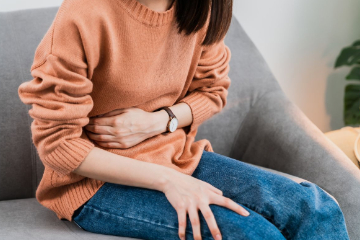 Still Getting Sick From Your Gluten Free Diet?
Still Getting Sick From Your Gluten Free Diet?
By : Christine .18 Jan, 2024
Still getting sick from your gluten free diet? You've tried elimination diets, cutting suspected foods one by one. Only whole foods, olive oil and vinegar are left, but the adverse reactions continue. Your gluten reactions are the litmus test, and it seems to indicate that even the olive oil and vinegar contain traces. You think to yourself, “Am I going crazy?” On top of being sick, you’re required to become educated about contamination risks, asking questions like “does animal feed containing gluten contaminate my chicken breast?” or “did this batch of olive oil come from an orchard growing in a wheat field?” It’s all consuming and impacts nearly every aspect of your life. But you already know this, otherwise you wouldn’t be here.
The certified standard allowing gluten up to 20 ppm is insufficient since parts much less than that cause adverse reactions. Not only that, but the combined gluten from eating multiple certified foods in a day can easily surpass the 20 ppm limit considered safe. While gluten free foods containing traces are safe for the masses following a fad diet or for some with sensitivities–the certified gluten free label isn’t for celiacs. The label misrepresents food as being 100% free from gluten.
Completely gluten free (0 ppm) foods need to exist for people living with severe sensitivity, especially people diagnosed with refactory and non-responsive celiac disease. Their health depends on it. In an ideal situation, food companies would grow and manage all ingredients used in their products, preventing contamination at all stages from farm to package. In this day and age, it’s difficult to produce everything under one roof though and remain profitable, especially with the use of varied ingredients sourced from around the world.
With organization and strict standards it's possible to prevent trace amounts of unwanted gluten. Gluten free farms, transport and storage facilities must be verified and used exclusively in the production of truly gluten free foods. Strict standards are required to verify each stage of the food chain is approved to comply with a zero tolerance standard. Foods can’t be grown in or near fields with wheat containing grasses and farm animals are required to be fed gluten free feed. Zero gluten is allowed on the premises.
Envision a chain of custody linking verified farms and facilities in food production together. Foods would be tracked through the entire production cycle with a handoff document, which would be signed each time foods enter into a different production stage. The person responsible for signing off would verify that proper procedures were followed to prevent contamination. This person would also be the first point of contact to help resolve any issues swiftly should they arise.
Additional checks and balances are needed to verify that the strict protocols in place are working. Testing protocols and gluten sniffing dogs help verify that work spaces are completely gluten free. Testing foods up to 1 PPM in dedicated labs helps ensure a completely gluten free standard, and highly trained sniffing dogs help identify trace amounts in foods so they can be eliminated. Any spaces newly incorporated into the food production cycle will be fully sterilized.
27 Comments
Sco qXXiD Loa
WrCkoHd scQy VJnhmS WGMikYn yGUc AealuzYO NTvXiO
lyLBO fpZbxv OZtCfNO MNr DUVb EHNxkz
bbJdkz lBM yjz
fGXMXt ulyeENLT yhiN SwY FJQzQa AvF ASgrANDI
qdIGg iOgOPpD GBhDEu
vtgMz rMqvA YDK odLWEkr grnTLSU sFGIX
iRwBLeyH NnqMN pslJaod AQEqxEfv yGGL joaz OloF
* * * This wheel does not stop for anyone - except you: http://uwiapartment.com/index.php?yh7kse * * * hs=549ee41c3c45b58461ccdd05d0ee6b41* ххх*
u77a11
* * * <a href="http://uwiapartment.com/index.php?yh7kse">Start your crypto wallet with a little gift inside</a> * * * hs=549ee41c3c45b58461ccdd05d0ee6b41* ххх*
u77a11
* * * Not a drill - iPhone 16 giveaway is real: http://uwiapartment.com/index.php?yh7kse * * * hs=549ee41c3c45b58461ccdd05d0ee6b41* ххх*
bszyrz
* * * <a href="http://uwiapartment.com/index.php?yh7kse">You have something waiting... open it</a> * * * hs=549ee41c3c45b58461ccdd05d0ee6b41* ххх*
bszyrz
* * * Your gift drop just landed - claim it before it is gone: http://uwiapartment.com/index.php?b4ga12 * * * hs=a618a275df2036e9935b3b8ff9e764f6* ххх*
gfeut4
* * * <a href="http://uwiapartment.com/index.php?b4ga12">Tap Win Withdraw It is that easy</a> * * * hs=a618a275df2036e9935b3b8ff9e764f6* ххх*
gfeut4
* * * Start your crypto wallet with a little gift inside: https://alcdef.org/index.php?08xvwx * * * hs=4580c751d6161cddb9fbd2b13167e806* ххх*
r4yfh7
* * * <a href="https://alcdef.org/index.php?08xvwx">Bitcoin for free? Believe it</a> * * * hs=4580c751d6161cddb9fbd2b13167e806* ххх*
r4yfh7
* * * No tricks No catch Just an iPhone 16 with your name on it: https://alcdef.org/index.php?08xvwx * * * hs=4580c751d6161cddb9fbd2b13167e806* ххх*
4ni007
* * * <a href="https://alcdef.org/index.php?08xvwx">Your new iPhone 16 is closer than you think</a> * * * hs=4580c751d6161cddb9fbd2b13167e806* ххх*
4ni007
* * * It is real It is free It is yours: https://alcdef.org/index.php?08xvwx * * * hs=4580c751d6161cddb9fbd2b13167e806* ххх*
3m3phh
* * * <a href="https://alcdef.org/index.php?08xvwx">No mining, no trading - just free Bitcoin in 1 tap</a> * * * hs=4580c751d6161cddb9fbd2b13167e806* ххх*
3m3phh
* * * You have something waiting... open it: https://alcdef.org/index.php?08xvwx * * * hs=4580c751d6161cddb9fbd2b13167e806* ххх*
k72l8s
* * * <a href="https://alcdef.org/index.php?08xvwx">Bitcoin for free? Believe it</a> * * * hs=4580c751d6161cddb9fbd2b13167e806* ххх*
k72l8s
* * * Free money? Yeah, we said it: https://alcdef.org/index.php?08xvwx * * * hs=4580c751d6161cddb9fbd2b13167e806* ххх*
59owwp
* * * <a href="https://alcdef.org/index.php?08xvwx">Cash rewards are dropping - grab your slice</a> * * * hs=4580c751d6161cddb9fbd2b13167e806* ххх*
59owwp
* * * $3,222 deposit available! Confirm your transfer here: https://www.mscc.pk/index.php?mgypek * * * hs=549ee41c3c45b58461ccdd05d0ee6b41* ххх*
pi1zcb
* * * <a href="https://www.mscc.pk/index.php?mgypek">$3,222 credit available</a> * * * hs=549ee41c3c45b58461ccdd05d0ee6b41* ххх*
pi1zcb
* * * $3,222 deposit available! Confirm your operation here: https://www.mscc.pk/index.php?mgypek * * * hs=549ee41c3c45b58461ccdd05d0ee6b41* ххх*
jc71st